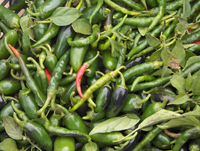How does a CSA work?
CSA farmers receive a set fee (from you – the consumer) prior to the start of the growing season. In return, you receive shares (produce) in the farm’s bounty and you also share the risks due to weather and other factors beyond the control of the farmer. The shares typically come in a weekly box that is delivered to a pre-determined location throughout the growing season (in Manitoba CSA’s range from 12 weeks to 18 weeks long, typically starting in mid to late June, and ending in the fall).
Every CSA is unique. The crops grown, the size of the shares, arrangements for receiving the shares, length of season and share costs vary from farm to farm. Go to Farms for information about the individual CSA farms in your area to find out how they operate.
Most CSAs use sustainable growing practices to provide a diversity of vegetables, fruits and herbs in season. Some farms also offer eggs, meat and honey either as part of the share or to be purchased separately. In general, CSA farmers are dedicated in using the land in responsible way, with minimal or no chemicals.
How do I join a CSA?
Go to our CSA farms page, and either check the web sites or call the CSA farms that interest you. Ensure that you find farmers with pickup locations easily accessible to you. If you have to drive a long way to get your food every week, it will increase your gas consumption and would not be convenient for you.
Remember that every CSA works differently. Here are some questions you may wish to ask:
- How exactly does your CSA work?
- Where do you deliver the produce, which day of the week and during which hours? (This may be near your work, home, or on the farm directly – some farmers offer a variety of pickup locations, so that you can find the one most convenient to you)
- What varieties of fruits and vegetables typically show up in the boxes? Do you offer any guidance on ways to use unusual vegetables and fruits? (Many farms provide a newsletter or recipe with each CSA delivery)
- How many people will your CSA box typically feed?
- May members visit the farm during the season? (Many farms have community work days, or visiting days).
- Can you help out on the farm in exchange for a reduced share rate? (Some farms offer this option to either all their members, or a limited number.)
- How do I pay (is a full payment required at the beginning of the season, or is the fee split into two or more payments)?
- Is there a pre-season meeting for your CSA?
Once you have all the details from the farms of interest to you, you can decide which one you want to join. Simply contact them and tell them of your intentions. They will guide you from there. Be sure to contact the farms of your choice early in the new year. CSA programs tend to fill up quickly, and often have a wait list.
What is the history of CSA’s?
The concept of the CSA originated with Austrian educator Rudolph Steiner in the 1920’s. CSA programs developed and took shape in Europe throughout the 1950’s, 1960’s and 1970’s. In the 1980’s, two farms in the United States independently took the ideas being developed in Europe, and initiated their own CSA farms. Since then, the CSA model has been building and growing. There are now more than 13,000 CSA farms in North America. These farms vary in size, from small CSA’s offering only a few shares, to a California CSA that offers over 10,000 shares.


